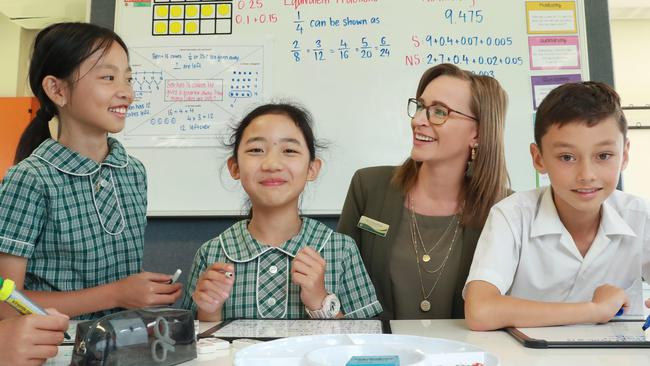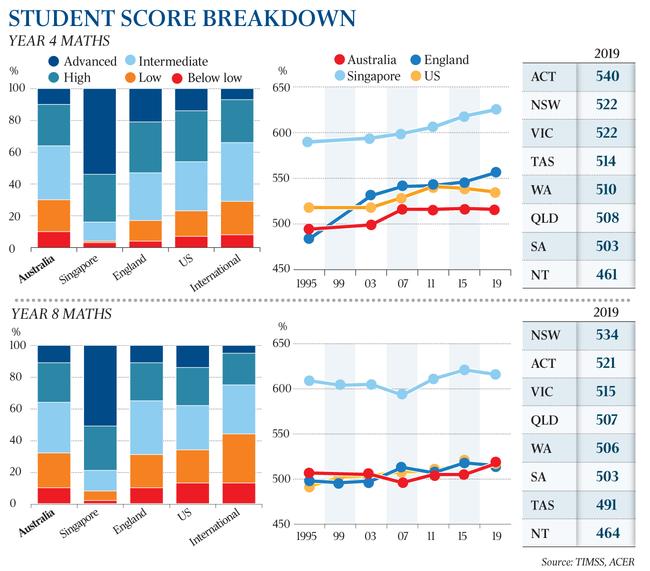Sting in tail of move up maths, science rankings
Australia has improved its overall performance on an international assessment of science and maths knowledge, but primary school maths achievement has stagnated.

Australia has edged up the global rankings in mathematics and science but concerns remain for up to a third of students who lack basic subject knowledge.
The results of the 2019 Trends in International Mathematics and Science Study, released on Tuesday, reveal that Australia has broken into the top 10 worldwide for secondary school maths and science, overtaking countries including England, the US, Norway and Kazakhstan.
Improved national scores for Year 8 maths and science, as well as Year 4 science, have been largely driven by an increase in the proportion of high-performing students and disproportionate gain from NSW, compared to other jurisdictions.
However, primary school students have continued to perform poorly in maths, leaving Australia ranked 27th out of 58 participating countries and trailing most of East Asia and Europe.
While the nation’s overall improved performance on the large-scale international assessment has been welcomed, senior education figures have raised concerns about the high degree of struggling students and pointed out that the nation has a long way to go if it wants to be internationally competitive.

In Year 4 maths, 30 per cent of Australian students failed to meet the TIMSS intermediate international benchmark, the agreed national standard of proficiency, whereby students are able to apply basic mathematical knowledge.
In Singapore and Hong Kong, just 4 per cent of students failed to attain proficiency.
And in Year 8 maths, despite Australia’s mean score improving, 32 per cent of students did not attain proficiency.
“These are welcome results for many Australian schools, students and teachers,” said Australian Council for Educational Research deputy chief executive Sue Thomson. “Strong results in mathematics and science are vital for our long-term economy, and these findings show that some progress has been made in (our goals).
“However, as always, we need to note that these results are not uniform, and that there is still a solid tail of underachievement that needs to be addressed.”
Australian Curriculum, Assessment and Reporting Authority chief executive David de Carvalho, who is overseeing a review of the national curriculum, said the results were “encouraging” but were “no cause for complacency”.
He singled out Year 4 maths results, for which there’s been no improvement since 2007.
Federal Education Minister Dan Tehan also said the latest TIMSS results suggested more work was needed.
“These results suggest our education system is moving in the right direction but, as the (OECD’s Program for International Student Assessment) results last year demonstrated, we all must maintain our focus on student outcomes and achieving the highest standards,” Mr Tehan said.

Australia’s declining PISA performance — along with its previously stagnant TIMSS results and lack of long-term progress in many of the NAPLAN domains — has been a cause of ample concern among education policymakers at a time when developing strong student capability in science, technology, engineering and maths is considered integral to Australia’s future economic growth.
Almost 15,000 Australian students from 571 schools were among 580,000 students worldwide to take part in the latest TIMMS assessment, conducted late last year.
Much of the recent gain, particularly in Year 8 maths and science, is down to NSW. As well as lifting its mean score in maths and science, NSW increased its proportion of very high performers, as well as the proportion who attained national proficiency.
NSW Education Minister Sarah Mitchell said the results were an indication reforms such as a new K-10 maths syllabus prioritising real-world maths, and a streamlined science syllabus, were starting to have an impact.
However, Centre for Independent Studies education research fellow Glenn Fahey said it was too soon to attribute any policy or initiative to the TIMSS results.
Sydney’s Carlingford West Public School has focused heavily on boosting students’ numeracy. Although it performed strongly in the National Assessment Program — Literacy and Numeracy, principal Andrew Williamson and his team felt they could do better.
“We invested in training the teachers in the content knowledge and curriculum, making sure they have explicit knowledge of how to teach maths concepts explicitly and make sure the students really understand what they learn,” Mr Williamson said. “It seems that it’s having a positive impact.”



To join the conversation, please log in. Don't have an account? Register
Join the conversation, you are commenting as Logout